Between 3D rendering furniture vs. photography, how do you decide which option is the best for your furniture company? Photography is the most widely used method for creating visual advertising material. Some companies also use CGI (computer-generated imagery) to deliver more intense artistic touches, although this is not as practical as a camera for producing an image. But is it the end of the debate?
Photography
After the initial studio setup or background layout composition for outdoor photography, a camera can
capture an object multiple times from various angles within minutes. Since the spread of digital cameras in the 1990s, photography has come a long way in terms of image manipulation to improve details and overall picture optimization.
Professional photographers don’t just click the shutter button and print images. They deploy powerful post-processing software and use their mastery to apply enhancements before publishing the image for marketing purposes. Now that prices for digital cameras have become more affordable, the technology is easily accessible by the vast majority of people.
Even in the hands of the most casual photographer, a simple point-and-shoot or perhaps smartphone camera is a capable device for capturing countless furniture images. It hardly takes any skill if you are willing to settle for candid photos without refinements of any sort afterward.
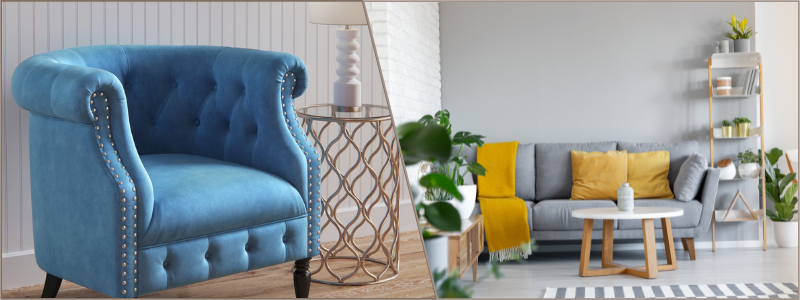
CGI with 3D rendering
The alternative to photography comes in the shape and form of 3D furniture rendering, a comparatively new method for creating product images. Digital cameras began to rise to popularity during the early 90s, but photography, as we know it today, was invented in the 1830s. The birth of CGI happened more than a century later, in the1960s. Much has improved throughout the decades in the 3D rendering realm. The pure-digital approach to product imagery means every object in a pictured scene is generated by a computer.
Physical objects are not necessary and are replaced with 3D models instead. They are positioned in a scene, which also is computer-generated. Crucial details, including colors, textures, lights, and shadows, are drawn using computer simulation to create a photorealistic image. Without physical objects, 3D rendering provides limitless possibilities in drawing scenes otherwise impossible to achieve using conventional photography.
RELATED: How to hire 3D designers and freelance 3D artists for your company project
3D Rendering furniture vs. photography – Comparison
- Marketing: You have seen time and again that 3D rendering is a better approach to furniture marketing. This is not always the case, however. In case you are running a small company making unique furniture designs, most of your operational budget probably goes into the actual designing and manufacturing parts of the business. The company has to hire some designers and skillful carpenters to produce the furniture in the first place. As a result, the marketing department doesn’t really have much money to spend.
- Visual advertising material: The purchase of a decent camera, a basic lighting setup, and a simple post-processing software program makes more financial sense to the company. The equipment still costs hundreds of dollars, but at least the money is sufficient to start a reasonable marketing campaign, whether on social websites or in print media. Considering the circumstances, photography is the ideal form of visual advertising material. A camera quickly produces an image, and the post-processing software can help improve color accuracy too. Given the right equipment, the untrained eye can capture an image crisp enough for online viewing and a small catalog layout. As the photographer’s skills improve over time, the results will get better.
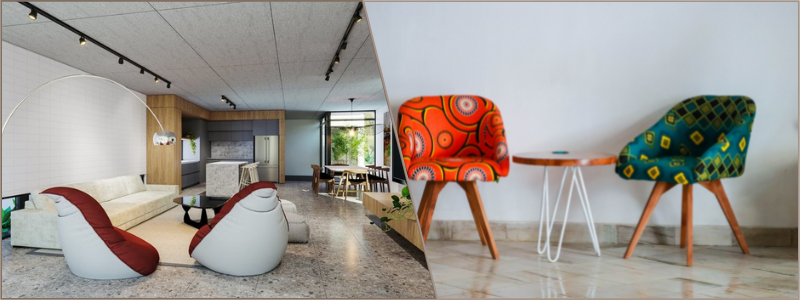
- Expertise: As far as 3D rendering services are concerned, the idea of giving an untrained person a computer and expecting to see good results at the end of the day is preposterous. CGI is not something anybody can do with a few clicks of a button. It takes weeks, if not months, of training just to make sure that a learner understands the basics. Not to mention the creation of 3D models, which are the prerequisite of rendering. Modeling a piece of furniture requires at least several hours, depending on the complexity. If done by the inexperienced, there is no guarantee the result will represent the actual object with any good accuracy, that is why we recommend using professionals that provides 3D modeling design services. Once the 3D assets are ready, the subsequent rendering process may take up to a full day for an intricate furniture design in a complex scene. During the time someone is working on the 3D modeling part of the job, a camera can capture hundreds of furniture images with little effort on the photographer’s side.
Factors to consider – 3D rendering furniture vs. photography
To make a fair comparison between photography and 3D rendering, every factor which may affect the final result must stand on equal footing. For example, both are handled by similarly experienced professionals in their respective fields, carried out using capable sets of equipment, and the objects should not be overly different. Such an equivalence is meant to avoid comparing apples to oranges.
While 3D rendering and photography, in this case, aim to produce furniture imagery, they have distinctive approaches to obtaining results. Equivalence is also necessary because every project presents unique challenges and requirements in the real world.
RELATED: How to get the best 3D rendering services for furniture design
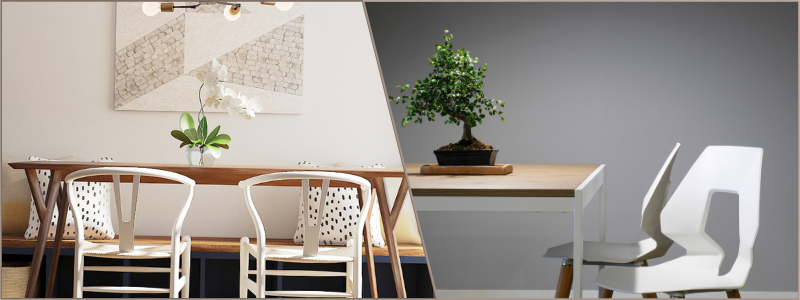
Cost factor
Under the presumption of “all things being equal,” let us start by first getting the most prominent question out of the way: cost. It is not about which option is the most expensive but rather which is the most cost-efficient. Since many years ago, industry giants like Wayfair and IKEA have used 3D furniture rendering services for product images instead of conventional photographs.
According to Wayfair, thousands of products in their catalog are created using Autodesk 3DS Max. However, the process is more elaborate than you may think. All renderings must be submitted to a QA tool before publication. During the review process, analysts and modelers work together to ensure that each model accurately represents the product. A set of renders showcasing a product from various angles is required for dimension verification and quality check.
In 2012, IKEA’s head of photography, Anneli Sjögren, said that 3D rendering was a clever way of saving money. Mr. SjorgenSjögren explained how computer-generated furniture imagery could be more cost-efficient and practical for marketing purposes thanks to its modifiability.
RELATED: What are CAD services prices and drafting design costs for freelance services firms?
Back then, just about 12% of IKEA’s contents for websites, catalogs, and brochures were 3D- rendering, and the number was expected to reach 25% the following year. As of 2014, the number soared to 75% of product images and 35% of non-product contents.
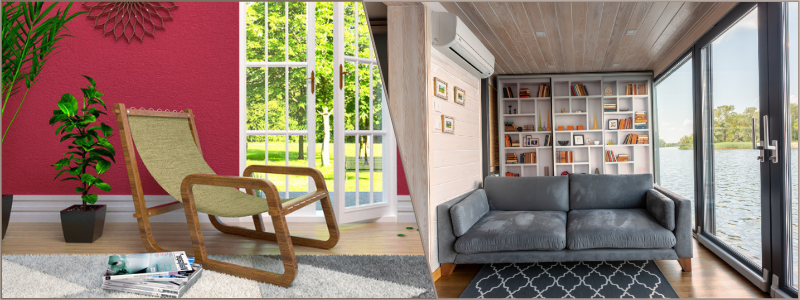
Despite the new trends and the increasingly widespread usage of 3D rendering services, photography remains a mainstay provider of furniture catalogs. Photography has been a favorite in the furniture industry for some excellent reasons. It is the quickest way to achieve an unbeatable level of realism and the most dependable to ensure dimension accuracy. Obvious challenges like complicated workflow and significant studio-related expenses are considered minor obstacles to attaining high-quality, authentic product photos.
The process of rendering furniture images
Rendering furniture images technically requires the same software and methods as creating visual effects for movies. Product marketing is comparatively on a smaller scale, which means the cost is more budget-friendly too. In fact, the technology has become aggressively more affordable, which means that even small- and medium-sized companies can take advantage of it in the same efficient manner as their bigger counterparts. The question about photorealism via 3D rendering no longer revolves around whether or not it is possible but who can achieve it under what timeline.
Is 3D furniture rendering worth it?
Regardless of the method of choice, however, it takes an experienced professional working with capable
equipment and under a reasonable deadline to produce either a photorealistic rendering or life-like
photograph of furniture. The cost for the equipment alone can be in the range of thousands of dollars in
each case.
For the amount of money you pay for an advanced camera and its additional essential accessories like a tripod, external flash, and lighting setup, you probably can get a dependable computer for 3D rendering. With that in mind, what really sets them apart in terms of cost is the skills you hire to get the job done.
RELATED: 19 Ways 3D product rendering is used by furniture companies to fuel sales growth
Hiring a professional
If you are thinking about having CGI work done on a piece of furniture, chances are you won’t buy a
computer required for the task. Instead, you hire a professional to handle everything on your behalf. The same thing applies to photography. The skills involved directly correlate to the overall expense. At the end of the day, you are not actually paying for an image, digital or printed, but the services provided to produce the image.
Once again, with the presumption of all things equal, 3D rendering is often found on the more expensive side of the two. In addition to the computer-renting fees, the cost for the software license, and significant power usage during the process (expenses most likely billed to the client), the overall premium also covers compensation for the professional doing the job. The most important factors affecting the price are the scope of work and difficulty level.
Scope of work
Rendering only happens when the 3D assets, which represent physical objects, have been made beforehand. An artist may have to build the models from scratch or purchase ready-made assets. It is a tall order creating the models alone, especially if the furniture in question is intricate or unique enough that any available-for-sale assets are too simplistic for the project. Professional photography is likely less expensive despite working on the same product. A photo and a render of an item of furniture is just one image, but the amount of work involved in the former is not as demanding as the latter. Photography does not involve creating the object, to begin with.
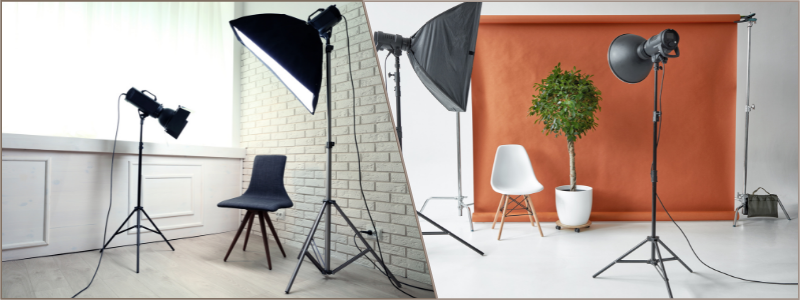
3D Furniture rendering vs photography
Studio setups and post-processing are not on the same level of complexity as 3D modeling. It is not to say photography is any less sophisticated and produces inferior results to CGI; in fact, both methods can yield equally impressive artworks. 3D Rendering costs extra for one very good reason: the 3D asset. A client can ask for either just the finished render or the complete set of entire raw materials used at every stage of the process.
The raw materials can be reused repeatedly for future renders, with or without changes, depending on project requirements. Having the 3D assets ready at the beginning of the project can reduce the price to a reasonable amount. Your next render will not involve intensive 3D modeling tasks; instead, the focus will be on modifying the available assets, including main objects and complementary details, to meet the new project brief. You save time and money in the long run, whereas photography falls short in this regard.
RELATED: 3D Rendering costs & 3D visualization prices for firms
Beyond the cost
Once you move past the cost issue, the differences between photography and 3D rendering become more apparent. Of all the factors relevant to the use of visual presentations for the marketing purpose of furniture pieces, those associated with 3D rendering surpass the potential benefits that photography can provide.
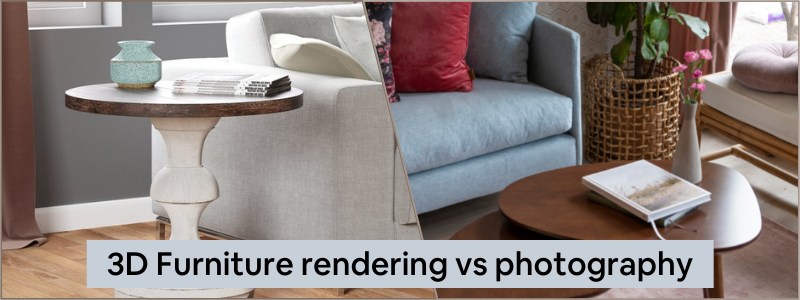
Logistics
Professional photography requires a well-thought-out setup, even for a simple furniture photoshoot in a studio. Things get even more complicated for outdoor photography, where the surrounding environment and weather likely affect the results. You may need to hire a transport team just to haul the set to the desired location. On the other hand, 3D rendering needs only a computer and nothing else, not even a camera.
Predictability
One of the first obvious distinctions concerns the logistics issue. Anyone who has organized a photoshoot is familiar with the typical challenge of carrying around loads of equipment to stage a set. The camera and accessories may not be the heaviest devices in the world, but everything else, such as lighting and props, including decorative items, tell a different story.
An often-cited downside of photography is a complex workflow that requires intensive collaboration between the photographer, marketer, and project manager. There isn’t any apparent reason why this must put photography at a disadvantage, especially if you consider that 3D rendering also employs the same collaborative effort. In the previously mentioned Wayfair example, analysts and modelers scrutinized a render before publication. If it is not a bad thing for 3D rendering, it shouldn’t hinder photography either.
A Photography studio, just like a renderer office, can be situated anywhere in the country or overseas. Both photographers and render artists can also deploy CRM (customer relationship management system) to maintain good communication with their clients throughout the project. A CRM enables where sellers and buyers can access every deliverable, give feedback, and keep track of the timeline. Also, the process works pretty much the same, in which the client oversees the progress and provides input for each milestone.
To say that a complex workflow negates photography, yet brings the opposite effect to 3D rendering, is not entirely accurate. It is much more appropriate to argue that CRM makes the results more predictable or at least has a better likelihood of meeting the clients’ expectations, even more so in 3D rendering. The predictability of the results has little to do with the CRM system itself but the nature of the technique.
Once a photoshoot is done, the photographer can only do so much to alter the composition and color
accuracy. Assuming the client wants a major revision, another photoshoot is the most viable option. A render artist can make changes to the preliminary render based on clients’ feedback without having to recreate all the 3D assets used. Alterations to viewing angle, detail highlights, and placement of objects are not uncommon. There is no need to prepare new furniture pieces and rebuild a set.
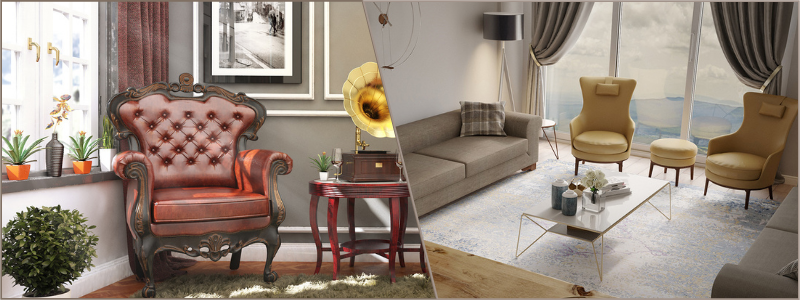
Creativity
If there is one aspect where 3D rendering outshines photography to the core, it is creativity. Every furniture company tries to stay ahead of competitors on the marketing front, and sometimes the effort calls for a curious strategy. One way to achieve that is to use unconventional product images, both on social media and in prints, to draw the attention from the public.
Regardless of the project brief, 3D rendering can create the scene without the need for physical objects. The furniture, decorative items, and details in the background are computer-generated. For example, you can place a modern sofa bed inside a stone age cave or a shiny, stainless-steel kitchen countertop in a medieval castle without an actual cave or actual castle. Suppose you want to highlight the fire-resistance feature of a cabinet. In such a case, you can render the furniture as if it is floating on top of flowing lava or inside an incinerator.
RELATED: How 3D rendering has revolutionized interior design
While modern photography can admittedly create the same imagery, it can only deliver the visual treat with a lot of help from CGI; post-processing software just doesn’t have the capabilities for it. Let us say you manage to find a castle for the photoshoot. Imagine the logistics concerned and the additional expense of using the property for commercial purposes, on top of the photographer’s fee. In contrast, 3D rendering can create the entire scene instead of renting one.
Creativity in photography is limited by what is physically available. The limit in 3D rendering is the artist’s
imagination and skills. An experienced render artist should be able to draw any imaginable objects, fictional or otherwise, build the 3D models, and then use them for the render. Essential elements, including lights, reflections, and shadows, require no actual lighting equipment.
Most 3D rendering programs come equipped with features to generate and simulate how natural and artificial light sources behave. As the rays of light hit a surface, they can bounce or refract depending on the characteristics of the surface, which are affected by types of materials, colors, and textures.
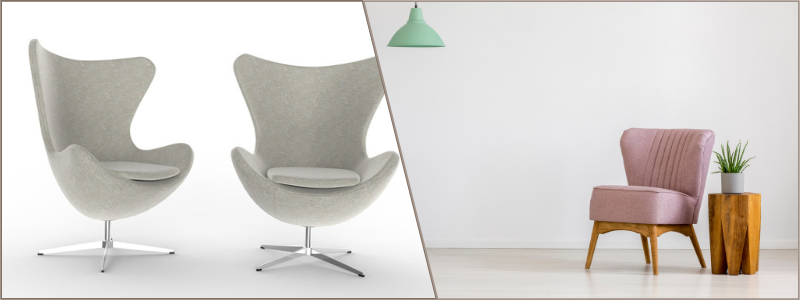
Customization
Apart from the unrestrained possibilities to create any scene, 3D rendering offers limitless customization options. An effective furniture marketing campaign may require multiple images to showcase the details and designs in various interior settings. There can be variations in colors, materials, dimensions, and additional ornamentations of the same basic model. Photography requires a new set of props for each different backdrop. Therefore, a single photoshoot session can use dozens of physical objects.
For a furniture model with various colors, the photographer will have to capture at least one image for each color. It is only possible and cannot happen unless the company lends some prototypes (or production versions) of the furniture. The crew may have to rework the backdrop multiple times if the company wants a unique setting for each color option.
There is only a little room for error because a slight mistake in the original capture can be challenging to improve post-processing. A photographer may call for another complex photoshoot to achieve perfection. All objects in a rendered image are 3D models made on a computer screen, providing an endless customization option. A render artist can alter the specifications of the objects as needed. There is no need for prototypes and other complementary items to build a scene.
Everything from furniture color to backdrop layout is a product of CGI and, therefore, customizable down to the tiniest detail. In short, 3D rendering eliminates the necessity of having any tangible product to create a furniture marketing image, not even the furniture itself. The camera angle and direction of light are customizable too.
RELATED: 3D Rendering vs. photography: How photorealistic 3D modeling can help your company
An animated render can provide an interactive zoom feature and an all-around perspective of the furniture for the viewer to have a more thorough inspection of the product. As long as an image still has not reached the final phase of the rendering process, making changes is within the bounds of possibility.
Most render firms or artists will allow their clients to propose some last modifications before the final render. It is better to make modifications at this point rather than do revisions at a later date. Revision of any sort must involve a re-render, which stretches the timeline further back.
3D Asset flexibility
A massive advantage of 3D rendering is assets reusability. A client should receive all the files used for the render once the project concludes. If you are not sure about this, please make it clear before hiring a CGI professional that you want the last deliverable for the project to include the final render -typically in image format – and the 3D models, both raw and raw and modified. Unless you provide the 3D assets at the beginning of the project, the renderer will charge an additional fee for creating or purchasing the 3D models required.
Every file attached to the render is essentially yours, so it only makes sense for you to receive them. You want to have the files because of their reusability. In future render projects for new furniture, using the same 3D assets will save you time and money. The real-cost saving benefit of 3D rendering materializes after the first project. Instead of making new 3D models each time, it is better to reuse the existing assets and apply some changes as you see fit.
Conclusion
It wouldn’t be accurate to assume that 3D rendering is an all-around better choice than photography for every furniture imagery project. Photography remains a reliable and quick method for obtaining furniture images for immediate publication; photographs are good when you are in a hurry. 3D rendering takes time to finish and is likely more expensive. However, if you consider what you get for the amount you pay, CGI can actually save money in the long run. You should not take the reusability and customizability factors for granted because they can and will serve you well in any future furniture render project.
How can Cad Crowd assist?
We have a network of artists and professionals who can assist you with any 3D furniture rendering project, irrespective of what you need to be done Why wait? Contact us for a free quote.
